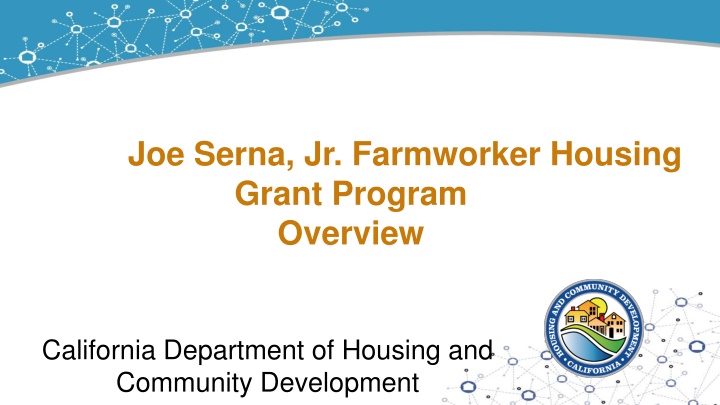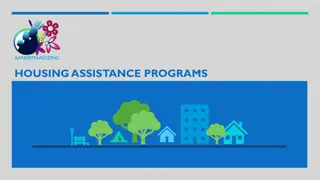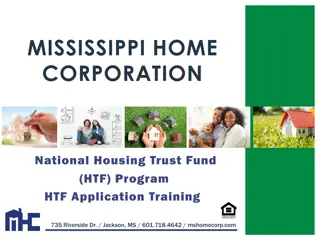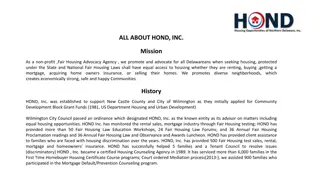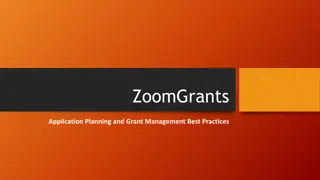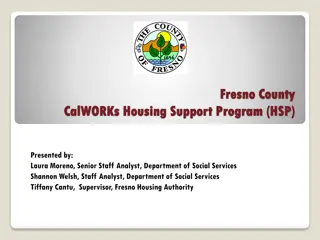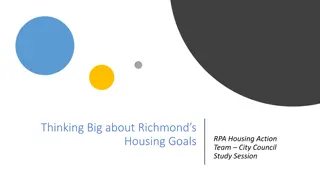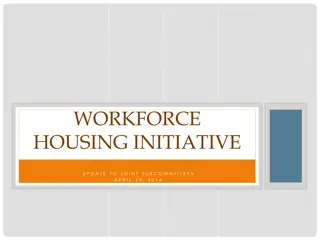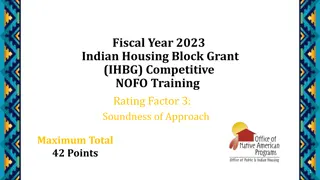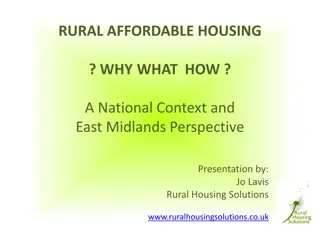Overview of Joe Serna, Jr. Farmworker Housing Grant Program
The Joe Serna, Jr. Farmworker Housing Grant Program by the California Department of Housing and Community Development aims to address the housing needs of agricultural workers through funding for housing construction and rehabilitation projects. The program provides grants and loans for multifamily and single-family housing initiatives, supporting the development of affordable housing options for farmworkers.
Download Presentation

Please find below an Image/Link to download the presentation.
The content on the website is provided AS IS for your information and personal use only. It may not be sold, licensed, or shared on other websites without obtaining consent from the author.If you encounter any issues during the download, it is possible that the publisher has removed the file from their server.
You are allowed to download the files provided on this website for personal or commercial use, subject to the condition that they are used lawfully. All files are the property of their respective owners.
The content on the website is provided AS IS for your information and personal use only. It may not be sold, licensed, or shared on other websites without obtaining consent from the author.
E N D
Presentation Transcript
Joe Serna, Jr. Farmworker Housing Grant Program Overview California Department of Housing and Community Development
AGENDA Introductions Getting Started Applicant Eligibility and Experience Eligible Activities Grant Amounts and Requirements Loan Amounts and Requirements Minimum Number of Assisted Units and Affordability Site Control Threshold Feasibility Evaluation Criteria
HCD Staff (1 of 2) Craig Morrow, Branch Chief, Access to Opportunity Deb Lindfeldt, Section Chief, Access to Opportunity Mauro Lara, Manager, Program, Design & Implementation Doug Truong, Manager, Program, Design & Implementation Gabriella Navarro, Specialist I, Program, Design & Implementation
HCD Staff (2 of 2) Amy Lopez, Housing Representative II, Program, Design & Implementation Tawny Macedo, Senior Policy Specialist, Fair Housing Joshua Standing Horse, Senior Policy Specialist, Tribal Affairs Spring Packard, Housing Representative II, Housing Policy Division
Introductions Tribal Members and Partners Name Role Organization Is your tribe federally recognized?
Welcome Welcome from Branch Chief, Craig Morrow
Purpose Joe Serna, Jr. Farmworker Housing Grant (FHWG) Program funds will be used to provide deferred-payment loans for new construction or rehabilitation of multifamily housing and grants for single-family new construction or owner-occupied rehabilitation programs, to address the housing needs of agricultural workers.
Authorities Governed by: 2017 Uniform Multifamily Regulations (commonly referred to as UMR s) State Program Regulations: Title 25 California Code of Regulations (CCR) Section 7200 Notice of Funding Availability (NOFA) and Notice of Guidelines Memorandum
Important Dates Notice of Funding Availability (NOFA) Posted: February 26, 2021 Formal Webinar: March 18, 2021 Application Portal Open: April 5, 2021 through July 6, 2021
Key Definitions (1 of 6) "Agricultural household" means an agricultural worker or workers and other persons who reside or will reside with an agricultural worker in an assisted unit. "Agricultural worker" means an individual who derives or prior to retirement or disability derived a substantial portion of his/her income from agricultural employment.
Key Definitions (2 of 6) "Agricultural employment" means employed in the cultivation and tillage of the soil; the production, cultivation, growing and harvesting of any agricultural or horticultural commodities; the raising of livestock, bees, furbearing animals, or poultry; dairying, forestry, and lumbering operations; and any work on a farm as incident to or in conjunction with such farming operations, including the delivery and preparation of commodities for market or storage.
Key Definitions (3 of 6) "Assistance" means a loan and/or grant provided from the Fund to an applicant, or a grant made directly to an agricultural worker. "Award" means a commitment of money from the Fund in the form of a grant or a loan that is made to a recipient by the Department.
Key Definitions (4 of 6) "Lower income households" means persons and families whose gross incomes do not exceed the qualifying limits for lower income families These limits are equivalent to 80 percent of the area median income, adjusted for family size and other adjustment factors by the United States Department of Housing and Urban Development. OTC stands for Over the Counter, applications can be submitted during a designated time period. Applications are reviewed in order they are received. Complete applications will receive funding until the application window is closed or funds are exhausted.
Key Definitions (5 of 6) Native American Lands means real property located within the geographic boundary of the State of California that meets both the following criteria: it is trust land for which the United States holds title to the tract or interest in trust for the benefit of one or more Indian tribes or individual Indians, or is restricted Indian land for which one or more tribes or individual Indians holds fee title to the tract or interest but can alienate or encumber it only with the approval of the United States; and the land may be leased for housing development and residential purposes under federal law. Source: 2017 Uniform Multifamily Regulations (page 4)
Key Definitions (6 of 6) Rental Housing Development a structure or set of structures which collectively contains 5 or more units. This does not include any health facility as defined by Section 1250 of the Health and Safety Code. Source: 2017 Uniform Multifamily Regulations, 8301(p)
Applicant Eligibility Duly constituted governing body of an Indian reservation or rancheria or a tribally designated housing entity. Local government agencies Nonprofit Corporations Limited Partnerships Limited Liability Company Note: For-profit entities are not eligible Applicants
Applicant Experience Rental Housing Rental housing developments Developed and owned at least one similar type and size project within the last five years; and Have staff with demonstrated experience managing at least one project occupied primarily by Agricultural households.
Applicant Experience Single-Family Single-family new construction or owner-occupied rehabilitation projects Successfully sponsored or supervised a similar program for at least two years within the last 10 years.
Applicant Experience Manufactured Homes Manufactured homes Must be operating or will operate a program to address and remedy the impacts of displacement of Agricultural Households from existing labor camps, mobilehome parks, or other housing due to government action to enforce health and safety laws.
Eligible Activities New construction or rehabilitation, with or without acquisition, of a Rental Housing Development Single-family new construction (a newly built home) in which the ultimate grantees are participants Owner-occupied rehabilitation Repairs necessary to protect the health, safety, or welfare of occupants of the housing
Eligible Activities (continued) Acquisition of Manufactured Housing not installed on permanent foundation as part of a program to address and remedy the impacts of displacement of farmworker families from existing labor camps, mobilehome parks or other housing
Maximum Grant Amounts Single-family homeownership projects Maximum $3 million $150,000 per Assisted Unit Owner-occupied rehabilitation projects Maximum $2 million $75,000 per Assisted Unit
Loan Terms Made by the Grantee to an Eligible Agricultural Household 20-year term Full repayment if home is sold or reconveyed within first 10 years Repayment reduced by 10% for each year if home is sold beyond tenth year
Maximum Project Funding Amounts Project without Low Income Housing Tax Credits (LIHTC) or using 4% LIHTC: Maximum $10 million Project using 9% LIHTC: Maximum $5 million
Loan Limits Initial base amounts: 9% tax credit: $95,000 per Assisted Unit 4% or no tax credits: $175,000 per Assisted Unit in a new construction Project located in a High Resource or Highest Resource area 4% or no tax credits: $150,000 per Assisted Unit
TCAC Opportunity Map To find the resource map for your area use this link: https://www.treasurer.ca.gov/ctcac/opportunity.asp
Funding Options Construction funding Permanent funding
MINIMUM NUMBER OF ASSISTED UNITS AND AFFORDABILITY
Rental Housing Development Rental Development Housing Minimum 10% Assisted units with income no greater than 30% Area Median Income Units distributed reasonably among bedroom sizes, this means there is a distribution of the bedroom sizes for various income levels. For example, not all units are one bedroom for very low-income households. Maximum Rent limit - 80% of Area Median Income
Site Control Requirement At the time of application site control Must be in the name of the Applicant or, Entity controlled by the Applicant If an entity other than the Applicant is named Organization documents must clearly demonstrate Applicant s control, for example if there is an agreement with a locality for the site, the Applicant will need to provide proof of the agreement.
Site Control Examples Types of site control Fee Title Ground Lease Purchase Option/Lease Option Sales Contract Disposition and Development Agreement (DDA) - Public Entities Exclusive Negotiation Agreement (ENA) must be for negotiation for acquisition and contain essential terms Land Sales Contract
Threshold Requirements Eligible Applicant Eligible Project Resolution authorizing the application for the grant Site Control Complete Application Refer to page 9 of the NOFA for additional threshold requirements
Financial Feasibility Organizational Documents & Resolutions Development Budget Rents Operating Expenses Cash-Flow
Evaluation Criteria This application is Over the Counter (OTC) There is no point score for this application Threshold Evaluation Feasibility Evaluation
Application Basics The application will be available on the HCD Joe Serna, Jr. Farmworker Housing Grant website: Joe Serna, Jr., Farmworker Housing Grant Program (FWHG) (ca.gov) Applications are submitted electronically to the Department s website.
Potential Program Barriers Discussion: Can you identify any potential program barriers?
HCD Contact Information (1 of 2) Joe Serna, Jr. Program Questions Serna Email Box- serna@hcd.ca.gov Program Staff Mauro Lara, Manager- Mauro.lara@hcd.ca.gov Amy Lopez, Representative II- Amy.Lopez@hcd.ca.gov
HCD Contact Information (2 of 2) Tawny Macedo, Specialist Tawny.Macedo@hcd.ca.gov Joshua Standing Horse, Senior Policy Specialist, Tribal Affairs, Joshua.StandingHorse@hcd.ca.gov California Indian Assistance Program- CIAP@hcd.ca.gov
Stay in the know: Sign up for HCD email at www.hcd.ca.gov
Follow HCD on social media Like us on Facebook: /CaliforniaHCD Follow us on Twitter: @California_HCD Follow us on LinkedIn: /company/californiahcd
